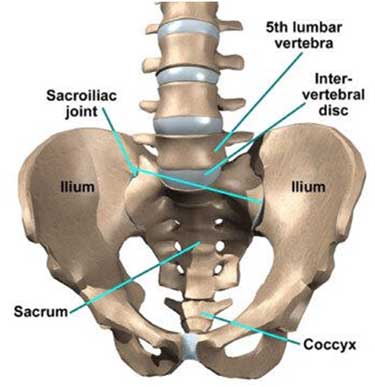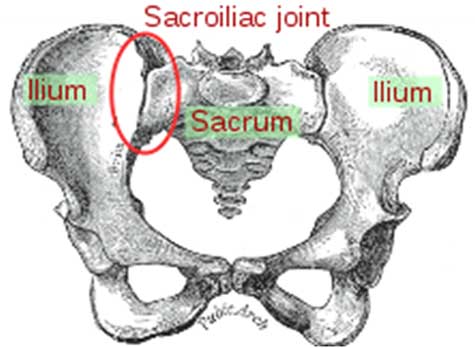
Sacroiliac Joint Inflammation
The sacroiliac (SI) joints are formed by the connection of the sacrum and the right and left iliac bones. The sacrum is the triangular-shaped bone in the lower portion of the spine, below the lumbar spine. While most of the bones (vertebrae) of the spine are mobile, the sacrum is made up of five vertebrae that are fused together and do not move. The iliac bones are the two large bones that make up the pelvis. The SI joints connect the spine to the pelvis. There are normally less than 4 degrees of rotation and 2 mm of translation at these joints. Most of the motion in the area of the pelvis occurs either at the hips or the lumbar spine. There are many different terms for sacroiliac joint problems, including SI joint dysfunction, SI joint syndrome, SI joint strain, and SI joint inflammation.


Ligaments -
1. Anterior sacroiliac ligament
2. Interosseous sacroiliac ligament
3. Posterior sacroiliac ligament
4. Sacrotuberous ligament
5. Sacrospinous ligament
Cause -
1. Degenerative arthritis (osteoarthritis)-
The SI joints have a cartilage layer covering the bone. The cartilage allows for some movement and acts as a shock absorber between the bones. When this cartilage is damaged or worn away, the bones begin to rub on each other.
2. Pregnancy-
During pregnancy, hormones are released in the woman's body that allows ligaments to relax. This prepares the body for childbirth. Relaxation of the ligaments holding the SI joints together allows for increased motion in the joints and can lead to increased stresses and abnormal wear. The additional weight and walking pattern (altered gait) associated with pregnancy also places additional stress on the SI joints.
3. Disorders –
• Gout
• Rheumatoid arthritis
• Psoriasis
• Ankylosing spondylitis
4. Fractures
5. Infection
6. Tumors of bone
7. Abnormal motion in the sacroiliac joint, either too much motion or too little motion
Symptoms -
1. Pain -
• Pain in the lower back
• Pain may also be present in the groin and thighs
• Pain is typically worse with standing and walking and improved when lying down.
• Bilateral
2. Stiffness and a burning sensation in the pelvis.
Diagnose -
1. CT scan
2. MRI
Physiotherapy Treatment -
1. Stretching or stabilizing exercises that can help reduce the pain
2. Sacroiliac belt
3. Manual therapy- anterior or posterior innominate rotational mobilization or a sacral thrust
4. Ice, heat and rest
5. Manipulations
6. Modalities for pain relief
7. Postural re-education

